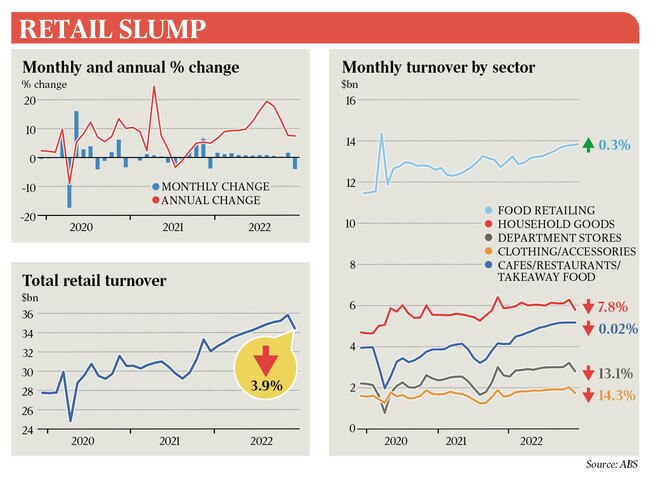December retail sales drop 3.9 per cent as consumers tighten belts
A large fall in retail sales over Christmas suggests runaway inflation and surging interest rates are taking their toll on household finances.

Australians sharply reined in Christmas shopping in December, in the first sign that runaway inflation and surging interest rates are weighing on household budgets.
Retail sales dropped by 3.9 per cent to record the first monthly fall for 2022, according to seasonally adjusted figures from the Australian Bureau of Statistics.
ABS head of retail statistics Ben Dorber said “the large fall in December suggests that retail spending is slowing due to high cost-of-living pressures”.
“Retail businesses reported that many consumers had responded to these pressures by doing more Christmas shopping in November to take advantage of heavy promotional activity and discounting as part of the Black Friday sales event,” he added.
Inflation reached 7.8 per cent in December and economists predict a collapse in consumption through 2023 as high prices and higher mortgage repayments bite.

Analysts, however, said they still expected the Reserve Bank board would deliver its ninth straight rate hike next Tuesday, taking the key cash rate from 3.1 per cent to 3.35 per cent.
Citi chief economist Josh Williamson calculated that spending on discretionary items fell by 5.4 per cent in December – the biggest drop since lockdowns in April 2020.
“The fall in nominal retail trade at the end of 2022 may be a signal that monetary policy is starting to work via the channel of discretionary spending. But the RBA can’t take this as a signal to stop tightening next week,” he said.
Mr Williamson said he expected a further cash rate increase next week, following by two more to a peak of 3.85 per cent.
The retail sales figures exclude spending on services such as travel and accommodation and which economists believe boomed over summer as Australians enjoyed the first Christmas holidays free of Covid restrictions.
Taking this into account, Capital Economics senior economist Marcel Theriault said “a solid increase in services spending means overall consumption should still have risen at a decent clip”. “But the engine of Australia’s reopening rebound has shifted down a gear,” Mr Theriault said.
Despite the surprisingly large fall in spending in December – analysts had forecast only a 0.2 per cent decline – retail sales remained elevated following a booming 2022 in which Australians continued to spend freely despite steadily higher interest rates, soaring inflation and plunging real wages.
Retail spending was up 7.5 per cent over the year to December, the ABS data showed.
Economists also noted the difficulty in accounting for seasonal factors thanks to the ever-growing popularity of the Black Friday and Cyber Monday sales, which are timed around the American Thanksgiving holiday.
The retail industries that suffered the largest falls in sales in December were those which experienced the biggest boosts during the November sales events, the ABS said. Department store sales collapsed 14 per cent, followed by a 13 per cent drop in spending on clothing and footwear, and an 8 per cent decline in household goods, according to the seasonally adjusted figures.
“Seasonal spending patterns continue to change and evolve around Black Friday and the holiday period,” Mr Dorber said.
“While there was a strong rise in original terms for December, as is expected in the lead up to Christmas, this year’s rise in original terms was smaller than those typically seen in past December months. This has led to the large seasonally adjusted fall.”
Food retailing was the only segment to record an increase in December – up a slight 0.3 per cent, while cafes and restaurants spending was flat. Shoppers spent less than usual across the states and territories, with 4.7 per cent declines in Victoria and Western Australia leading the falls. Retail sales in NSW fell by 3.4 per cent.







To join the conversation, please log in. Don't have an account? Register
Join the conversation, you are commenting as Logout